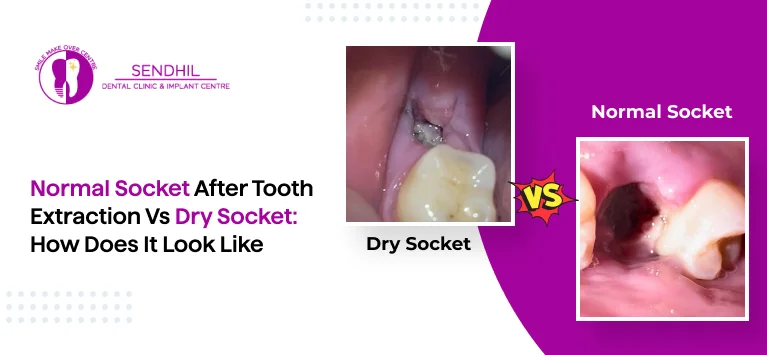
Normal Socket After Tooth Extraction Vs Dry Socket: How Does It Look Like
Most of the dental problems are addressed by dental fillings, root canals, oral antibiotics, etc. However, after all these, if nothing works out, tooth extraction is the only option. Tooth extraction is usually not painful during the procedure, but after the procedure, it may be sore for a few days. It was healing after tooth extraction, which is essential to avoid discomfort and pain. Therefore, this blog ensures that you understand the difference between a regular socket and a dry socket, what a normal socket and a dry socket look like, and how to avoid a dry socket after tooth extraction.
Table of Contents
What happens after a tooth extraction?
Usually, after a tooth extraction, the body begins the healing process automatically by forming a blood clot in the empty socket where the tooth was removed. After this healing, is it progressing well or not? If not, then what is the problem in healing? To understand all this, you need to know the difference between a normal socket and a dry socket.
Normal Socket After Tooth Extraction
Within the first 24 hours of tooth extraction, a blood clot forms in the socket where the tooth was removed. This clot protects the nerves and bones from exposure and prevents them from bacteria and infections. It also serves as the foundation for tissue regeneration.
In the next few days, granulation tissue (new white tissue) starts to replace the blood clot. Collagen, white blood cells, and blood vessels combine to form this tissue, which is needed for healing. This process is normal with minimal discomfort, and it is called a normal socket after tooth extraction.
Dry Socket
In a dry socket, the blood clot is either dislodged or dissolves too soon, exposing the underlying bone and nerves. This could cause significant pain, an empty socket, and no signs of healing tissue. So, the area may appear dry and require prompt dental treatment to manage the pain caused by a dry socket.
How Does Normal Socket After Tooth Extraction Look Like
The above picture shows a normal socket after tooth extraction. In this image, a blood clot protects your nerves, and the yellow stuff is granulation tissue, which will turn pink soon. When you have a normal socket, just keep being careful, try not to irritate it, and be very gentle until it heals.

How Does a Dry Socket Look Like
The above image shows a dry socket. Instead of a dark clot, you’ll likely see an exposed bone that appears white or gray. The surrounding gum tissue may look irritated, and the socket may appear dry without signs of healing tissue. A dry socket is often accompanied by severe pain.
The most common thing to judge is whether the healing is happening or the bone is exposed by a dislodge of blood clots, which you can only find by pain. A dry socket will cause severe pain and discomfort compared with a normal socket.

What Causes Dry Socket After Tooth Extraction?
Several factors can irritate the blood clot and dislodge it to cause a dry socket. Also, if you need to take good care of your normal socket, consider these factors. They are,
- Aggressive rinsing or spitting: When you do aggressive rinsing or spitting, it could cause vigorous mouth movements and disturb the clot.
- Drinking through a straw: The suction created while sipping through a straw can dislodge the clot.
- Smoking: Chemicals in cigarettes can hinder healing and increase the risk of clot dislodgement.
- Poor oral hygiene: Improper cleaning can lead to infection, which may break down the clot.
- Trauma to the extraction site: Excessive physical activity or pressure on the site may interfere with the clot. Wisdom teeth are at high risk when we put pressure on them.
If dry sockets are left untreated, they can cause severe pain and delay the healing process. Therefore, they require professional treatment to relieve the pain and discomfort.
When to Contact Your Dentist?
Normally, after a tooth extraction, you may notice mild pain, discomfort, swelling, or slight bleeding. However, it’s better to consult the dentist immediately when you notice the below signs during the healing process.
- The pain gradually increases compared to previous situations after extraction, and it must reduce as the days increase.
- When you see the visible bone in the socket or a lack of blood clot formation.
- An unpleasant taste or foul odor comes from the extraction site, which may signal an infection.
- Swelling or fever, which could indicate an infection.
- Prolonged bleeding that doesn’t stop even after applying pressure with gauze.
- Pain radiating to your ear or jaw, which is a common symptom of dry sockets.
Takeaway
Usually, it’s challenging to face the pain caused by tooth extraction. So, the best care is necessary to avoid dry sockets to get faster healing and avoid pain. In order to prevent dry sockets and get a healing normal socket after tooth extraction, follow the post-care methods carefully. If you are suffering from dry sockets or need tooth extraction with expert treatment and post-care guidance, contact Sendhil Dental Clinic & Implant Center.




